 Mine Neutralization
Mine Neutralization Mine Neutralization
Mine Neutralization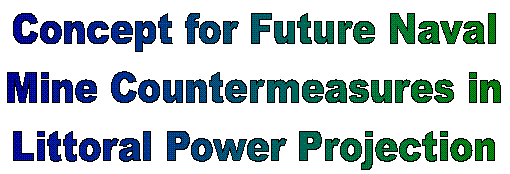
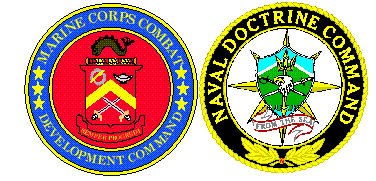
From the Sea, Forward…from the Sea, and Operational Maneuver from the Sea chart the direction for Naval Forces of the 21st Century through a vision for future sea-based littoral power projection. Future Naval MCM in Littoral Power Projection is part of an on-going process to open debate and provide alternatives for future investigation and experimentation. The concept describes a conceptual framework, baseline operating tenets, and future operational capabilities to enable Naval access across the range of maritime operations .

1 MAY 1998
INTRODUCTION
CONCEPT LINKAGE
PURPOSE AND SCOPE
ANTICIPATED THREAT
MINE EFFECTS
ENVIRONMENT
FUTURE OPERATIONS
Command Considerations
MCM Tasks and Infrastructure
Self Protective Measures (SPM)
Intelligence Preparation of the Battlespace:
Deterrence and Prevention
Surveillance and Reconnaissance
Clear, Breach and Avoid
Ship-toObjective Maneuver (STOM)
Operating Areas
Port Break in/out Operations
Independent Operations
FUTURE OPERATIONAL CAPABILITIES
![]()
| The Littoral - "Those regions relating to or existing on a shore or coastal region, within direct control of and vulnerable to the striking power of naval expeditionary forces" |
This paper provides a framework for developing naval MCM capabilities in the littoral environment focusing on operations circa 2010 – 2015. It describes the anticipated battlespace, states the objectives for developing MCM capabilities, and describes required operational capabilities to support these objectives.
A National Security Strategy for a New Century states that the U.S. military plays an essential role in building coalitions and shaping the international environment through means such as the forward stationing or deployment of forces, defense cooperation and security assistance, and training and exercises with allies and friends. This requires significant forward presence involving naval forces in often crisis-prone regions.
| MCM GOALS
* Elevate MCM: - Full commitment of Naval leadership
for well equipped and trained MCM forces. * Develop a C4I
architecture which supports the full range of MCM operations. - rapid deployment and employment * Develop an all source precision
data base available to all MCM forces with the capability to provide real-time
environmental assessments and forecasts. |
Forward presence and engagement are themes of Joint Vision 2010 (JV 2010), which is supported by the Navy and Marine Corps concepts: Forward … From The Sea (FFTS), Navy Operational Concept (NOC), and Operational Maneuver from the Sea (OMFTS). A common thread among these concepts is a clear requirement to maneuver naval forces from the sea into the littorals. The Marine Corps concept, OMFTS, envisions the use of the sea as maneuver space to project combat power ashore. With the shift in focus by naval forces from the open ocean strategies of the Cold War to the littoral regions, the potential for mines to frustrate naval plans has increased. Naval forces must have an effective MCM capability to operate in distant waters in the early stages of regional hostilities, to protect vital follow-on sealift, to allow swift ship to objective maneuver in littoral power projection operations, and to conduct follow-on clearance or humanitarian operations.
The Navy-Marine Corps team has transitioned from legacy MCM operations which focused on port break in/out to operations involving expeditionary MCM in forward operating areas - "littoral MCM." MCM in littoral power projection will facilitate maneuver warfare by providing a capability to apply strength against weakness. This requires the ability to identify and exploit such weakness. Rather than pursue an attritionist approach through cumulative destruction, the commander must subject the enemy’s mines and obstacles to rigorous surveillance and reconnaissance in order to locate and avoid them altogether or maneuver through existing gaps. When avoidance is not an option and adequate gaps are not readily identifiable, rapid, in-stride breaching of the enemy’s mines and obstacles will be conducted. Organic MCM will provide forward deployed naval forces the capability to accomplish mine detection, classification, identification, avoidance, and when necessary, neutralization. Supporting MCM will be able to reinforce, as required, when the mission demands a capability beyond the capacity of organic systems.
Future operations will place a premium on highly mobile naval forces with responsive, accurate and tailored MCM capabilities continuously available to the naval force commander. Current MCM capabilities will not satisfy the requirements of the future battlespace -- they are limited by lengthy timelines for surface assets to arrive in theater, inadequate integration of assets, minimal reconnaissance means, and operational pauses created by the slow, deliberate nature of MCM operations. Today, these operations utilize inadequate communication and computer systems, employ dated and simplistic tactical decision aids (TDAs), and are generally only conducted in relatively benign environments under non-hostile conditions. The significant advantages of surprise and relative operational speed are lost. Limitations in U.S. capability to conduct truly rapid breaching can cede tactical advantages to the enemy.
|
"...the very shallow water (VSW) region is a critical point for our offensive forces and can easily, quickly and cheaply be exploited by the enemy. The magnitude of the current deficiency in reconnaissance and neutralization in these regions and the impact on amphibious assault operations were demonstrated during Operation Desert Storm." Maj. Gen. Edward
J. Hanlon Jr., |
This concept examines future operational capabilities. It considers the level of hostilities from crisis through war, across the range of military operations, and throughout the battlespace. The concept focuses on considerations and factors that affect MCM in support of operations in the littorals and briefly discusses five plausible mine threat scenarios:
In the future, the U.S. must be prepared to face a range of mine threats potentially far more lethal than those available today. More than 48 of the world's navies have mine-laying capabilities and access to mine inventories. At least 30 countries are actively engaged in the development and manufacture of sophisticated new mines. Of these, 20 are known mine exporters. An even greater number of nations possess the ability to lay land mines. Although most of the world's stockpiled mines are relatively old, they remain lethal and easily upgraded. Often described as "poor man's artillery," mines present a significant threat on land, the beach and in waters shallower than 300 feet. This is where the greatest number of mines are most effective and where power projection missions require that U.S. forces operate.
| A potential adversary is anticipated
to have:
* a proven capability of existing
rudimentary but large mine and obstacle stockpiles from the 20th Century,
sourced predominantly from the former Soviet Union (FSU). |
Threat nations may field advanced mines on their own, bypassing traditional development cycles by adapting market technologies to their needs, often with the specific goal of defeating U.S. objectives. They will likely mine choke points, interrupt SLOCs, and use mines and/or obstacles in protective and defensive fields as counter-mobility weapons at anticipated landing or port break-in sites. Minefields will be laid on land, in deep to shallow water, and in conjunction with obstacles in very shallow water, in the surf zone, and over the beach. These defenses will be an integrated part of an adversary’s overall plan.
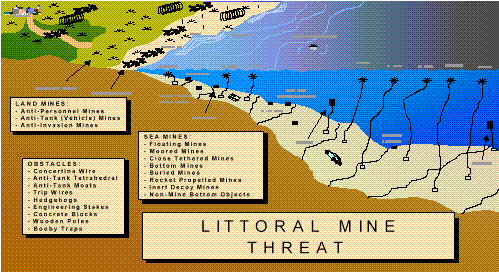
The ability to strike with little prior notice will remain a critical requirement for future naval operations. Littoral minefields demand significant attention and resources to avoid their restricting or disrupting the ability to maneuver at or from the sea. Although there will be some mines with improved capabilities, the greatest threat will be sheer numbers, rather than technological sophistication. Mines developed during the next 15-20 years will incorporate improvements, including:
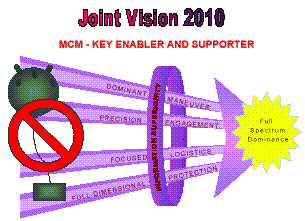
Although mines attack individual targets, their effects can be far-reaching. In practical terms, a force might be forced to modify its course of action due to the perceived or actual presence of mines.
Successful MCM provide U.S. and combined naval forces the ability to maneuver and protect seaborne forces and logistics assets critical to accomplishing the mission. While successful MCM alone will not ensure mission accomplishment, the disproportionate effect of a single mine strike might be enough to threaten mission accomplishment. Some examples of the potential impact of enemy mining operations include the loss of or delays in the arrival of:
The complex littoral environment, with its dramatic variability, exacerbates the problems and challenges associated with MCM battlespace knowledge. The diverse physical operating environment -- above and below the water's surface and over the land -- provides the foundation of MCM planning, preparation and operations.
| Important environmental characteristics:
* Meteorology: wind, air temperature/humidity,
cloud cover/percipitation |
There are numerous geophysical parameters to consider when operating in the littorals -- shortened scales of temporal and spatial variability are common to both the oceanic and atmospheric littoral regions. For example, major causes of variability in the littoral include ocean fronts, fresh water run-off, synoptic and local weather disturbances, sea and/or land ice and tidal fluctuations.
These phenomena make it very difficult to accurately observe and forecast environmental parameters and most importantly, to predict their effect on sensors, and thus military operations, especially MCM.
Military forces of the future will fight in conflicts ranging from major theater war (MTW) to smaller scale contingencies (SSC). Naval forces will often be on the leading edge of such operation as they combine strategic mobility with maneuver to significantly expand the battlespace.
| OPERATIONAL MANEUVER FROM THE SEA (OMFTS)
* Focuses on the operational objective. |
In a mine threat environment, MCM are key enabling activities. They must be given high priority and must be fully integrated into planning. Such planning will ensure the commander is able to maintain the flexibility that freedom of maneuver provides. Organic MCM, integral to the forward deployed force, will be capable of spanning the range of military operations. It must be equally effective at negating the impact of a mine threat on a dispersed force or forces operating in close proximity. Supporting forces will primarily be required for large area clearance when the battlespace permits, as well as for follow-on MCM operations. Furthermore, long term MCM plans will include the development of coalition MCM forces as force multipliers to the U.S. efforts. In all theaters where mines pose a threat, allied forces will be engaged to promote the establishment of multi-national MCM task forces. Theater Commanders must, in future, include allied forces in combined MCM exercises in order to exchange tactics and philosophies, with the ultimate goal of building a more capable overall MCM force.
| SUPPORTING AND ORGANIC MCM FORCES
SUPPORTING: land, air, surface, or sub-surface forces trained and equipped specifically for, and focused on, MCM operations. ORGANIC: Capability that is carried in forward deployed forces to allow early MCM operations. |
Mines and obstacles clearly have the potential to hinder the commander's ability to accomplish the mission. They will be used to slow or stop military operations and provide a means to control military and commercial traffic flow.
To accomplish the mission, the commander must know the role that mines and obstacles play in the enemy’s overall offensive/defensive plan. The commander must be aware of avoidance techniques, the force’s MCM capabilities and self protective measures (SPM). The commander must judge whether the operational advantages accrued from crossing into a mine danger area (MDA) out weigh those anticipated from inaction or avoiding the minefield altogether. To meet that challenge, the capability must exist to readily reconnoiter, collect and disseminate intelligence, and mark or designate MDAs. This detailed knowledge must be gathered through early, sustained and clandestine MCM reconnaissance. In certain cases, the commander may be given no alternative but to breach a minefield and perform limited clearing operations in support of the overall concept of operations. In some smaller scale contingencies, the objective may be to clear all mines.
MCM support and enable the commander to accomplish the mission. The MCM concept forms the basis for the MCM infrastructure (organization, materiel, doctrine, education and training, leadership and quality personnel) and MCM-focused tasks (the individual actions required to successfully complete the MCM mission), which build upon each other to provide naval forces the capability to counter the mine threat. MCM tasks can be grouped together under four general types:
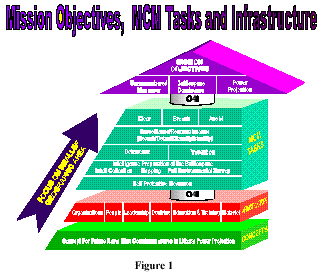
Figure 1 relates MCM infrastructure and tasks to achieving objectives. The backbone of the hierarchy is C4I. Each group of tasks is continuously enabled by the previous group and tends to focus increasingly on a smaller geographic area. Tasks are not conducted in isolation. They can be compressed, blurred, or simultaneous, and are integrated with the most critical needs and requirements of commanders at all levels. The tasks are examined in more detail below.
Effective MCM requires a highly tuned and focused infrastructure. To sustain the force and instill operational concepts, high quality people will be a key ingredient for success. The judgment, creativity, and fortitude of our people will remain the key to success in future MCM operations. Turning concepts into capabilities requires adapting leadership, doctrine, education and training, organizations, and materiel to meet the high tempo, high technology demands of the future battlespace.
C4I is the pillar that supports the infrastructure and operational tasks. It involves inputs and outputs to and from the entire force. The commander will require the ability to integrate the MCM battlespace picture derived from a wide range of sources, platforms, and sensors. Deconfliction and execution of MCM tasks will require a highly automated command, control and communication system, and tactical aids for planning.
Commanders at all levels require a shared awareness of the battlespace through synthesized data gathered from near and real-time surveillance and reconnaissance systems, historical records, strategic and tactical intelligence, and environmental and mapping systems.
The C4I system must provide the necessary connectivity with other ground, air, naval, joint, combined or allied forces and should provide a real time interface with national and theater sensors to ensure timely and accurate exchange of information. Of particular importance is the system’s ability to support integrated MCM and amphibious operations with the rapid dissemination of mine, obstacle, NOMBO/clutter positions, and their neutralization status. It will require extensive use of global precision positioning technology.
SPM must be available to all forward deployed and supporting forces. Integral to future platform design will be the requirement to:
SPM are not the solution to the mine problem, however, the development of these systems remains imperative. If the situation dictates, naval forces must be able to maneuver at risk in mine threat environments before any form of mine reconnaissance has been completed. Follow-on non-combatants and military sealift units are unlikely to be fitted with SPM.
Environmental and Global Geospatial Information Systems support in the littorals requires:
Intelligence derived from a combination of human sources, as well as traditional and non-traditional sensors and platforms will be essential. Improved national, theater and tactical sensors, processing and analysis are required to assess enemy mining intentions, capabilities, locations of mines and barriers, and the composition of overall defenses. The results of these efforts may reside in a number of different data bases, all of which must be assessed, fused and distributed to the tactical commander.
Peacetime. Forward presence operations are a form of deterrence. They allow peacetime intelligence collection to assess the threat and accurately monitor the operational posture of potential adversaries by identifying mine stockpiles and dispositions of mine laying forces. Furthermore, MCM training and exercises must be conducted to convince potential adversaries that U.S. MCM capabilities are formidable and can readily prevail.
| Prevention The following mine denial nodes
may be considered for targeting:
* Importation, procurement or production area. |
Crisis / Conflict. Preemption exploits an adversary's need to base mine-laying forces and infrastructure at fixed locations. Preemption may employ both lethal and non-lethal technology and may seek to either deny the use of mines or the ability to effectively deploy them. Prevention can take the form of neutralizing enemy mining capabilities, denying access to critical areas for enemy mine-laying forces, or deception operations. When Rules of Engagement (ROE) allow, offensive measures will be a major element of initial battlespace preparations. To the degree that offensive measures can be non-lethal, they will be more politically acceptable and more likely approved.
| Rules of Engagement
Prior to the commencement of hostilities, preempyion may not be compatible with strategic objectives and, even during armed conflict, may pose an unacceptable risk of collateral damage. Furthermore, whil highly desirable, approval to neutralize all but a platform actually engaged in minelaying and a mine-layer in transit may be considered highly controversial. A "first strike" policy may draw undesired and adverse media attention and public opinion ("CNN effect"), especially if there is collateral damage. |
Interdiction aims to neutralize enemy mine-laying forces before they arrive in the intended areas of employment. The coordinated employment of many different sensors will be required to identify, locate and track the mine-layer. Interdiction requires more assets than preemptive tactics, but may benefit from less restrictive ROE.
Early and sustained surveillance and reconnaissance operations are fundamental to MCM operations. They are the activities designed to make a rapid assessment of the limits and density of a minefield, or the absence of mines. If operational surprise is imperative, clandestine preparations are required. Early in any campaign, commanders require the location and extent of enemy barriers, obstacles and minefields. The identification of areas of high clutter density and exploitable areas will also be tactically significant. Development of the areas and timetables for reconnaissance actions requires a complete understanding of the intelligence picture, environment, operational objectives, timelines, and the number and capabilities of MCM assets available for the task. This understanding can be enhanced through the use of tactical decision aids (TDAs) and planning tools. The conduit for this knowledge will be the C4I architecture.
There is no single source surveillance and reconnaissance system. The commander requires a mix of MCM systems. This mix must be predominantly low vulnerability, autonomous and organic to the forward deployed force, and provide rapid and wide area detection, classification and identification. A near real-time assessment of the mine threat is required through computer aided mine detection, classification and identification (CAD, CAC and CAI) techniques. These systems must be effective from deep water, across the beach to objectives inland. Autonomous vehicles should be recoverable for future use and rapid turnaround. At the unit level, maritime forces require an on-board mine detection sensor suite.
While an organic MCM capability is necessary in high threat, immediate need scenarios, supporting MCM platforms and systems must be available for preparation, follow-on operations, post conflict operations, and large areas (e.g., carrier battle group operating areas) when battlespace dominance is attained and time is not critical. The commander may require large area and total mine clearance in scenarios such as smaller-scale contingencies and humanitarian mine clearance without encumbering or distracting other combatants from their mission.
Following the identification and precise location of mines, the commander must decide, based on the operational situation, to either destroy the mines or mark for tactical avoidance. Mine clearance operations (designed to clear or neutralize all mines and obstacles from a route or area) require autonomous systems organic to the force. These systems must have a high degree of assurance and must be integral to the mine detection and identification platform for rapid 'search to destruction' of the mine threat.
Other mine clearance techniques are required, such as influence sweeping or jamming. These may be required in areas where sensor searches are inefficient, typically due to the environmental conditions (e.g., clutter density) or mine burial.
Follow-on forces require similar mine clearance systems that provide a higher priority to 'total' mine clearance (zero tolerance in a humanitarian scenario). It is acknowledged that this will take a longer time and will require supporting forces.
The commander also requires in-stride breaching systems to take advantage of surprise and initiative and to maintain momentum without causing pause or delay. These systems will be used by assault forces and must be effective against a wide range of mine threats from deep water through to the objective ashore.
The following scenarios briefly exemplify the threat that may be faced by forward deployed forces. In each case the problems associated with the scenario are different, but equally challenging. The MCM tasks described above are relevant to each situation, but the difficulties of the problems in each vary. For example, surveillance and reconnaissance in a strait may be confined to a limited area when compared to an operating area, which may be thousands of square miles. Equally important to all, however, is intelligence preparation of the battlefield. The commander needs to know whether an adversary has laid mines (the location, density and type), which areas are absent of mines, and just as importantly, the impact of the environment.
The SLOCs, in particular the geographically constrained areas such as choke points, narrows, straits and estuaries around the world, are easy and obvious targets for mining activity. Naval forces must be able to transit these high threat routes to demonstrate presence as hostilities escalate and position for forward operations and power projection. MCM operations will have added imperatives if timelines are shortened and a high speed transit is necessary to meet operational demands. One method to allow for a higher speed of advance (SOA) is the use of off-board organic MCM sensors ahead of the force. Mines will be neutralized or electronically marked for avoidance to allow the safe passage of following forces.
Organic MCM Operations in Peacetime, Crisis and Conflict:
* Advance clandestine reconnaissance (selected
units)
* Ship to Objective Maneuver.
* SLOCs, choke point transit.
* Naval area operations e.g. CVBG operating area, ARG/MEU(SOC) ops.
* Port break in/out.
* Independent operations (e.g. NEO, TBMD, TLAM strike ops).
* Intel collection, mapping and environmental survey.
* Exercises and training.
Supporting MCM Operations in predominantly reduced or low threat environment:
* As listed above for organic MCM if time and
threat environment allow.
* SLOCs and choke point transit for follow-on forces, MPF, merchant vessels.
* Post amphibious assault follow on clearance operations to enable build-up
and sustained operations ashore.
* Embarkation, debarkation.
* Port clearance ops.
* MOOTW (e.g. humanitarian, administrative and post conflict mine clearance).
* Intel collection, mapping and environmental survey.
* Exercises and training, research and development.
STOM is the tactical implementation of OMFTS. It incorporates the philosophy of maneuver warfare, which is based upon pitting strength against the enemy’s weaknesses by avoiding defenses and exploiting gaps. STOM is a radical departure from the traditional linear approach to amphibious operations. In STOM, the Landing Force will have the freedom to launch its attack from over the horizon at sea, well beyond the range of enemy direct fire weapons. Elements of the Landing Force will maneuver during the approach to the beach under the orders of their tactical commanders, just as they would if attacking on land. Commanders of Landing Force subordinate units will select specific littoral penetration points for their individual units -- based on the changing tactical situation -- even as they approach the shore.
In STOM, surprise is critical to success. Unlike traditional amphibious operations which are typically preceded by lengthy and deliberate battlespace preparation, to include mine/obstacle reconnaissance, marking, breaching, and clearing, STOM operations will be planned to achieve tactical surprise. Any pre-assault preparations will be performed clandestinely; many of the functions traditionally performed prior to the amphibious assault will be conducted "in stride."
STOM presents special challenges for mine countermeasures operations. The goal is to streamline the existing deliberate sequence of mine countermeasures actions to achieve a capability which will support rapid maneuver by the Landing Force at sea, as well as on land. Elements of the Landing Force may be required to conduct mine and obstacle breaching from deep water, through shallow water, very shallow water, the surf zone, and on to objectives located well inland. In STOM, the Landing Force cannot be constrained by a requirement to attack along prescribed lanes, as in traditional amphibious operations. Elements of the Landing Force must possess the freedom of action to maneuver at will, both at sea and on the land, either avoiding mines and obstacles or conducting very rapid in-stride breaching operations.
The ability of naval forces to safely transit to, and operate in, a dedicated area ensures the flexibility of projecting power when and where the commander desires. Depending on the geography, operating areas may be vulnerable to mining. Furthermore, the risk of actuating influence mines increases considerably when multiple ship passes are likely within a constrained area. For this reason, early MCM preparations will be required using advanced deployment of autonomous, off-board organic MCM platforms. This is necessary to ensure the operating area is thoroughly searched and/or cleared and marked before the main force arrives. Organic MCM assets will continue to search and monitor the area after the main force arrives. If the battlespace environment and time permit, supporting forces will be used to augment organic assets by conducting reconnaissance and clearance operations ahead of, and when the naval force arrives.
An opposed port break-in presents great risk, especially against a well-prepared and equipped opponent. Consistent with the tenets of maneuver warfare, ports may be neutralized or even seized by the use of other more efficient and less costly means. Nevertheless, a port break-in operation is conceivable, especially against a less sophisticated, poorly equipped and untrained adversary.
Organic MCM forces are required to support the port break-in and break-out operations. The location of the port, assessment of the mine threat, the critical need for U.S. naval forces to be underway, and immediate availability of organic or supporting MCM forces will determine the commander's courses of action. In a relatively benign environment, such as the terrorist mining of a harbor entrance, initially organic and then supporting MCM forces can be used to establish a precise navigable channel clear of mines. The certainty that all mines have been cleared or that a safe channel has been established will be at the expense of time.
When port mining is tied to other events, for example, to blockade a strategic objective or in an effort to bottle up forces, the need to get U.S. forces underway may override the mine clearance confidence factor. The commander will use the force's organic MCM assets for mine detection and neutralization, calling forward immediately available supporting MCM capability to assist in clearing a channel sufficient to enable the force to deploy as soon as possible.
There will be missions for naval forces which require dispersal away from the main force for independent operations (e.g., theater missile defense, naval surface fire support, TLAM strike, special operations forces (SOF) insertion, non-combatant evacuation operations). Since the focus of these operations will be away from the main force, the MCM assets provided for mine reconnaissance, avoidance and limited clearance must be those systems organic to the individual unit conducting the mission. Supporting MCM assets may neither be compatible with the mission, nor available. Preparation tasks will be essential; independent operations emphasize the need for MCM-focused environmental and intelligence assessments to be available to all naval forces. Furthermore, compatibility for a particular mission requires that selected units within a naval force have off-board organic mine detection, avoidance or neutralization systems in addition to an on-board detection and classification sensor suite for close-in mine avoidance.
U.S. forces must be able to significantly reduce the time and risk of conducting operations in a mine threat environment to an easily interpreted and straight-forward 'GO / NO GO' criteria. They must have the capability to support the commander and rapidly overcome operational pauses resulting from mines.
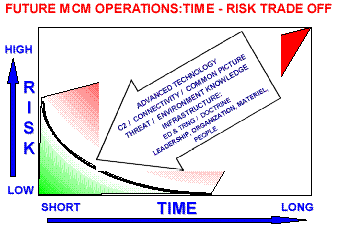
There is no simple solution to enemy mining. Naval forces must develop and integrate innovative technologies, platforms, and sensors, and exploit the environment through a focused and streamlined infrastructure.
Leadership. The future of MCM will depend on incremental and revolutionary technological development, on the DoN to make a substantial investment in the research and procurement of such systems, and on the naval leadership to commit already heavily taxed forces to the MCM mission. This commitment must be placed across the whole spectrum of technologies, infrastructure, connectivity, threat and environmental knowledge with further consideration towards operational tasking, proficiency, maintenance, and sustainment.
Education and Training. As the onus of the MCM mission migrates from purely supporting MCM forces to a combination of organic and supporting forces, MCM education and training must evolve in two distinct and equal directions and in tempo with the development and deployment of innovative systems.
First, MCM must be viewed as an equal partner among the traditional naval warfare areas. It is a vital and critical enabler to carrier-based air power projection, sea-based air and missile defense, undersea warfare, and amphibious power projection envisioned in the early 21st century. A full appreciation for the mine problem must be inculcated in the Naval Service. Furthermore, the Navy and Marine Corps must establish a cadre of mine warfare experts whose specific mission is to project the mine concepts of the next century. The importance of professionalism in mine warfare and improving the understanding of the warfare problem cannot be overstated.
| New Equipment x Zero Trainig = Zero Capabillity |
Second, future MCM systems will employ state of the art technology. Consequently extensive training will be required to operate and maintain these systems and understand the new technologies. Unit and force level training must also evolve. MCM training in the future should:
| Units and Task force MCM Training
Mine Warfare plays a negligible role in unit training exercises. Mines are usually only "played" up until they begin to maneuver. It is important that mines be played realistically, take combatants and vehicles and people out of play, impact maneuver, and force units to react to these training exercises as they would in a realistic mined environment. Training of commanders must emphasize time and risk of MCM operations. |
Doctrine. Current MCM doctrine has not significantly changed from that used during World War II. The operational situation of future naval power projection forces may reduce significantly the time available to MCM forces to accomplish their missions. Organic MCM forces must be closely integrated with and continuously provide information to the commander. This will place an enormous reliance on a variety of autonomous platforms and sensors. These differences will make future doctrine noticeably different from that of today and will mandate MCM doctrine be developed, evaluated and revised as experience, systems and operations evolve.
As part of this initiative, the gamut of widely misunderstood or misinterpreted mine warfare terms and phrases must be reviewed and re-aligned with other warfare areas. A common and simple criteria must be established for defining the level of risk and level of effort in MCM operations.
Materiel. Future operational capabilities should focus scientific and academic communities to solve the mine problem. Low cost, reduced life cycle support, user friendliness, commonality, modularity, and efficiency should be the bywords. Military applications must be grasped from non-military, commercial and academic research and development of emerging systems.
| COTS, common and modular systems such as:
* Software, e.g., improved automated detection,
classification and identification processing for sensors. Key benefits: * REDUCED training, logistics and maintenance
needs |
Commercial enterprises and non-military agencies world-wide continue to use developing technologies in new and innovative ways. Government or commercial-off-the-shelf (GOTS / COTS) technologies lead to lower costs, as well as shorter development and acquisition times. The availability of such systems for exploitation by an adversary must also be recognized as a vulnerability. Historically, countermeasures appear soon after any new technology is first used or revealed. Thus over time, any perceived advantage is negated.
Organization. With the wide dissemination and availability of the battlespace picture, the commander will have to communicate updated intentions as the situation rapidly changes. To take advantage of short-lived opportunities presented, the organization must be highly responsive, interoperable, and adaptive to changes in intent. The trend towards increased flexibility, high mobility, and flatter organizations with enhanced C4I will result in many traditional staffing processes being performed through reachback. As organic and supporting systems and C4I are introduced to naval forces, the naval and MCM organizations must adapt to employ them. Effective C4I must allow MCM functions to be performed from a variety of platforms within a highly dynamic environment.
Command, Control, Communications, Computers, Intelligence (C4I). Shared awareness is critical. A robust, real-time, joint and combined capable C4I system architecture will be central to coordinated, multi-platform operations. C4I connectivity enables all relevant forces to respond to contacts, integrate collective knowledge, and best exploit their capabilities. The C4I architecture will be continuously "networked" to:
Commanders must have access to all relevant sensor data in their current or projected area of operations. Friendly force and environmental information must be available so commanders can optimize their tactics and sensor systems' performance. The volume, variety, and time-sensitivity of the data, and its multiple sources all increase the importance of managing it correctly. Naval forces will require shared awareness through:
| The ability to collect data may far outstrip the ability to process it - new automated tools need to be explored that can screen new data and determine what shall be passed directly to the warfighter. |
Environmental Exploitation. The capability must exist to exploit the battlespace environment, from the upper atmosphere to the sea floor, in real, or near real-time. The environmental impact on operations in the littoral is so significant that without a thorough description of the battlespace successful outcome is in jeopardy.
Environmental data will be collected by a variety of sensors. These sensors will be integral to manned or autonomous space and airborne platforms, ground and surface/subsurface units. These sensors may be surface/subsurface devices that are expendable, small, cheap, and scatterable. The capability to assimilate the gathered data into a precision physical, biological, optical and acoustic high resolution model for real-time environmental assessments, as well as forecasts, will be required. The processed data must also be coupled to the common tactical database and TDAs. Database tools will include such features as high resolution environmental mapping from sparse data and explicit simulations to be used for detailed operational planning, training and rehearsing. During future MCM operations, decision aid software and the force's common environmental picture will be driven by fused data from extensive multi-source collection and analysis efforts, off-board forecasts, and the historical environmental database. Finally, an effective communications network with accurate positioning in the air, on the ground, and underwater is a key technology issue.
Sensors and weapons must be environmentally adaptive. Sensors and systems require the capability to measure environmental parameters, use the data in modeling and mission planning, and immediately optimize MCM sensors automatically or through operator intervention.
Coordinated and Multi-platform MCM. Coordinated, multi-platform MCM operations optimize available sensors and systems, regardless of the host platform, to ensure that the most effective is used when and where it is most needed.
Fundamental to the MCM concept are early and accurate surveillance and reconnaissance techniques to rapidly and efficiently locate mines and minefields, and identify areas where mines are not present. This will require detection of mines or enemy mine laying activity anywhere in a large (thousands of square miles) area. If U.S. or allied naval forces maneuver or operate in dispersed formations, the mine search area will increase several-fold. Effective surveillance and reconnaissance will rely on some form of cueing (normally from intelligence sources) to concentrate the search or in the worse case, a datum established from a casualty.
Platforms. Rapid and wide area detection, classification and identification of mines, for avoidance, clearance or breaching is critically dependent on platform characteristics. Future platforms require high performance capabilities in terms of speed, precision navigation, self-protective measures, range, endurance, communications and sensor payloads, mission turn-around time, and in the case of off-board systems, the 'footprint' within the host platform. An important consideration will be the autonomy of the system and the constraints it puts upon the host platform’s ability to conduct other warfare missions. The mix and numbers of organic MCM platforms and sensors required to achieve mission accomplishment must undergo rigorous analysis, experimentation, modeling, and simulation.
For large area operations, post conflict operations, or when organic assets are not available, supporting MCM forces must be available to the commander within a specified period.
Sensors. The harsh littoral environment markedly reduces effectiveness of mine search and targeting sensors. This degradation is dramatic in the surf zone and riverine areas. Successful detection, classification and identification of mines requires environmentally adaptive sensors, capable of overcoming poor signal-to-noise ratio at a significant stand-off distance. Future sensors require high reliability and performance in processing speed, false alarm rate, sensor search rate (area coverage), positional accuracy, and in-situ environmental sensing.
MCM sensors must have the capability to conduct on-board (man out of loop) rapid mine detection, classification and identification. As the need for high-speed maneuver increases, multi-spectral MCM sensor capabilities must be expanded for full integration with maneuvering forces. Sensors must have sufficient fidelity to quickly and automatically discriminate clutter and NOMBOs from real mines. It is essential that the system capabilities offer very high reliability and confidence factors to support mission objectives. Furthermore, these sensors must be developed to provide rapid feedback to the operator of their performance and platform vulnerability.
Mine Clearance, Breaching and Avoidance Systems. The commander must have the capability to confidently avoid mines or achieve the assured destruction or neutralization of a mine threat in the absolute minimum time. These systems must be effective against buried, ground, moored or floating mines from the deep water to the anti -invasion mine on the beach and the anti-tank or anti-personnel mine on land. Furthermore, confidence that the 'job has been done' requires the capability to relay accurate battle damage assessment (BDA).
An organic, in-stride mine and obstacle breaching capability is required for the landing force to facilitate rapid transition from deep water through the shallow water, surf zone, over the beach, and to inland objectives. The capability to expand the breach is also required to allow for sustainment and follow-on forces. Supporting forces and selective organic platforms will have the capability to deploy autonomous vehicles to neutralize mines using a variety or combination of methods such as influence sweeping or other techniques. In some instances, these vehicles may be used to conduct wide area 'influence jamming ' to allow the safe passage of vulnerable units.
Self Protective Measures. SPM will not overcome the threat, but form part of the hierarchy of MCM tasks required to combat mines. While individual units must be able to operate autonomously and have the ability to use organic sensors to detect, classify and identify mines, the risk in a high mine threat environment of a 'leaker' is always possible.
Selected platforms must have the capability to maneuver through a mined area using detect and avoid sensors and possess a limited clearance capability to be able to free themselves when trapped within a mined area. All combatants must have the capability to employ stealth -- to manipulate unit signature and avoid triggering mine actuation. Signature control must improve to the point where mine actuation by a military unit rarely occurs.
Sea-borne and some amphibious assault craft and land vehicles require the ability to withstand and resist the damage of a close proximity mine detonation. This may include methods such as improved construction, shock hardening for equipment and machinery, and protective materials.
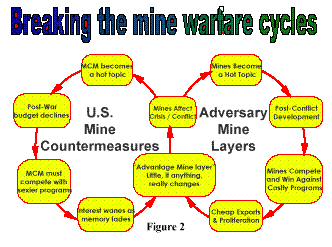
![]()
In the aftermath of Desert Storm, the Navy and Marine Corps have done much to understand what went wrong with MCM, and are taking steps to address the shortcomings. All current interest in MCM will be wasted unless it is sustained until the next crisis. Historically, the U.S. has not done well in the MCM area. Figure 2 depicts two cycles that have been repeated several times: interest in mines (re)commences when they cause problems during a war or conflict, but later, when budgets and force structure are reduced, countermine capabilities must compete for resources with higher-visibility programs. Interest in MCM then wanes. The commander of the next war will not have the equipment and assets of previous commanders, nor the time (reduced now to hours and days vice weeks) to conduct MCM to detect, identify and breach or clear an enemy minefield that may be more sophisticated than that faced in the last war.
Mines are inexpensive weapons which have dramatically demonstrated the ability to stall, disrupt, or thwart a naval force -- a strategic victory for the adversary. Following a conflict, the mine layer replenishes stockpiles, an attractive option when compared to more costly sophisticated weapons. Little if anything changes; the advantage remains with the mine layer. Mines will be used in the next conflict; they remain a serious threat to U.S. forces.
If the Naval Service expects to have a viable MCM capability in forward and power projection operations, these cycles must be broken. MCM must be a priority in an operational environment that will focus on littoral warfare. As budgets and force structure shrink, the commitment to MCM programs must be permanent. A backslide on the commitment to MCM will have serious repercussions for the Navy-Marine Corps team. The future commander will face a serious dilemma in the next major conflict. Operational maneuver flexibility will be threatened by concern for damage or loss to a mission essential unit.
History indicates that a significantly greater commitment is needed to institutionalize MCM to the status of a warfare mission area. By establishing and maintaining the momentum for positive change, the Naval Service will fully prepare Sailors and Marines to defeat mines in future operations.
| RECOMMENDATIONS
DoN and Naval leadership provide a full commitment to the evolution of MCM that will enable well equipped and trained MCM forces to be deployed in future military operations. Research and development community be challenged to discover a revolutionary breakthrough which allows a technology 'leap' and compresses the development and deployment time of a family of highly efficient, affordable, autonomous MCM sensor platforms. Elevate MCM:
Develop both supporting and organic MCM systems which are capable of:
Develop an all-source, real-time, precision data base which provides a common environmental battlespace picture for all MCM forces. It must have the capab |